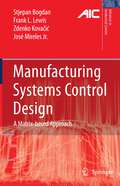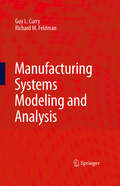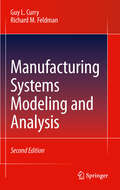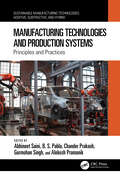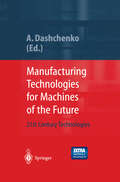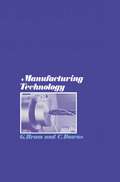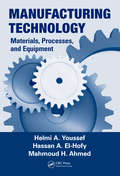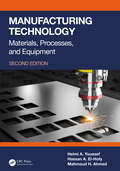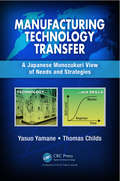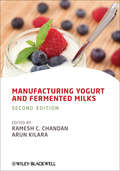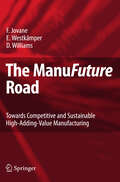- Table View
- List View
Manufacturing Strategy: The Research Agenda for the Next Decade Proceedings of the Joint industry University Conference on Manufacturing Strategy Held in Ann Arbor, Michigan on January 8–9, 1990
by John E. Ettlie Michael Burstein Avi FiegenbaumManufacturing System Throughput Excellence: Analysis, Improvement, and Design
by Herman TangImprove key metrics of manufacturing performance with this accessible guide Manufacturing throughput refers to the quantity of products that can be produced within a period and with available resources. Enhancing manufacturing throughput is crucial for a business’s success. However, managing and improving throughput can be challenging due to the complexity of manufacturing systems and their operations, which involve numerous variables. To effectively manage and improve system throughput, it is essential to adopt a scientifically guided methodology and practices. Manufacturing System Throughput Excellence is a unique book that provides a concise and practical overview of manufacturing throughput management. It includes best practices for achieving improved throughput on the production floor and explores the connections between production management and system design. The book emphasizes practical, executable approaches, drawing on the author’s 25+ years of industry and academic experience. It serves as an indispensable tool for businesses looking to boost manufacturing efficiency and drive improved outcomes. Manufacturing System Throughput Excellence readers will discover: The latest and effective approaches for achieving manufacturing operational excellenceKey pillars of manufacturing excellence: production management, maintenance management, quality management, and system designSpecific principles and methods on bottleneck identification and buffer analysis Insightful connections between academic research and industrial practiceSummaries and end-of-chapter exercises to reinforce learning Manufacturing System Throughput Excellence is a unique and comprehensive guide for manufacturing practitioners and researchers, as well as mechanical and industrial engineering students in advanced manufacturing courses.
Manufacturing Systems: Theory and Practice (Mechanical Engineering Series)
by George ChryssolourisOverviews manufacturing systems from the ground up, following the same concept as in the first edition. Delves into the fundamental building blocks of manufacturing systems: manufacturing processes and equipment. Discusses all topics from the viewpoint of four fundamental manufacturing attributes: cost, rate, flexibility and quality.
Manufacturing Systems and Technologies for the New Frontier: The 41st CIRP Conference on Manufacturing Systems May 26–28, 2008, Tokyo, Japan
by Mamoru Mitsuishi Kanji Ueda Fumihiko KimuraCollected here are 112 papers concerned with all manner of new directions in manufacturing systems given at the 41st CIRP Conference on Manufacturing Systems. The high-quality material presented in this volume includes reports of work from both scientific and engineering standpoints and several invited and keynote papers addressing the current cutting edge and likely future trends in manufacturing systems. The book’s subjects include: (1) new trends in manufacturing systems design: sustainable design, ubiquitous manufacturing, emergent synthesis, service engineering, value creation, cost engineering, human and social aspects of manufacturing, etc.; (2) new applications for manufacturing systems – medical, life-science, optics, NEMS, etc.; (3) intelligent use of advanced methods and new materials – new manufacturing process technologies, high-hardness materials, bio-medical materials, etc.; (4) integration and control for new machines – compound machine tools, rapid prototyping, printing process integration, etc.
Manufacturing Systems Control Design: A Matrix-based Approach (Advances in Industrial Control)
by Stjepan Bogdan Frank L. Lewis Zdenko Kovacic Jose MirelesThis book covers all the steps from identification of operations and resources to the transformation of virtual models into real-world algorithms. The matrix-based approach presented here is a solution to the real-time application of control in discrete event systems and flexible manufacturing systems (FMS), and offers a sound practical basis for the design of controllers for manufacturing systems.
Manufacturing Systems Engineering: A Unified Approach to Manufacturing Technology, Production Management and Industrial Economics
by Katsundo HitomiThis second edition of the classic textbook has been written to provide a completely up-to-date text for students of mechanical, industrial, manufacturing and production engineering, and is an indispensable reference for professional industrial engineers and managers.In his outstanding book, Professor Katsundo Hitomi integrates three key themes into the text:* manufacturing technology* production management * industrial economics Manufacturing technology is concerned with the flow of materials from the acquisition of raw materials, through conversion in the workshop to the shipping of finished goods to the customer. Production management deals with the flow of information, by which the flow of materials is managed efficiently, through planning and control techniques. Industrial economics focuses on the flow of production costs, aiming to minimise these to facilitate competitive pricing.Professor Hitomi argues that the fundamental purpose of manufacturing is to create tangible goods, and it has a tradition dating back to the prehistoric toolmakers. The fundamental importance of manufacturing is that it facilitates basic existence, it creates wealth, and it contributes to human happiness - manufacturing matters. Nowadays we regard manufacturing as operating in these other contexts, beyond the technological. It is in this unique synthesis that Professor Hitomi's study constitutes a new discipline: manufacturing systems engineering - a system that will promote manufacturing excellence.Key Features:* The classic textbook in manufacturing engineering * Fully revised edition providing a modern introduction to manufacturing technology, production managment and industrial economics* Includes review questions and problems for the student reader
Manufacturing Systems Engineering: A Unified Approach to Manufacturing Technology, Production Management and Industrial Economics
by Katsundo HitomiThis second edition of the classic textbook has been written to provide a completely up-to-date text for students of mechanical, industrial, manufacturing and production engineering, and is an indispensable reference for professional industrial engineers and managers.In his outstanding book, Professor Katsundo Hitomi integrates three key themes into the text:* manufacturing technology* production management * industrial economics Manufacturing technology is concerned with the flow of materials from the acquisition of raw materials, through conversion in the workshop to the shipping of finished goods to the customer. Production management deals with the flow of information, by which the flow of materials is managed efficiently, through planning and control techniques. Industrial economics focuses on the flow of production costs, aiming to minimise these to facilitate competitive pricing.Professor Hitomi argues that the fundamental purpose of manufacturing is to create tangible goods, and it has a tradition dating back to the prehistoric toolmakers. The fundamental importance of manufacturing is that it facilitates basic existence, it creates wealth, and it contributes to human happiness - manufacturing matters. Nowadays we regard manufacturing as operating in these other contexts, beyond the technological. It is in this unique synthesis that Professor Hitomi's study constitutes a new discipline: manufacturing systems engineering - a system that will promote manufacturing excellence.Key Features:* The classic textbook in manufacturing engineering * Fully revised edition providing a modern introduction to manufacturing technology, production managment and industrial economics* Includes review questions and problems for the student reader
Manufacturing Systems Modeling and Analysis
by Guy L. Curry Richard M. FeldmanThis textbook was developed to ?ll the need for an accessible but comprehensive presentation of the analytical approaches for modeling and analyzing models of manufacturing and production systems. It is an out growth of the efforts within the Industrial and Systems Engineering Department at Texas A&M to develop and teach an analytically based undergraduate course on probabilisticmodeling of m- ufacturingtype systems. The level of this textbook is directed at undergraduate and masters students in engineering and mathematical sciences. The only prerequisite for students using this textbook is a previous course covering calculus-based pr- abilityand statistics. The underlyingmethodology is queueing theory, and we shall develop the basic concepts in queueing theory in suf?cient detail that the reader need not have previously covered it. Queueing theory is a well-established dis- plinedatingback to theearly 1900’sworkof A. K. Erlang, a Danish mathematician, on telephone traf?c congestion. Although there are many textbooks on queueing theory, these texts are generally oriented to the methodological development of the ?eld and exact results and not to the practical application of using approximations in realistic modeling situations. The application of queueing theory to manufact- ing type systems started with the approximation based work of Ward Whitt in the 1980’s. His paper on QNA (a queueing network analyzer) in 1983 is the base from which most applied modeling efforts have evolved. There are several textbooks with titles similar to this book.
Manufacturing Systems Modeling and Analysis
by Guy L. Curry Richard M. FeldmanThis text presents the practical application of queueing theory results for the design and analysis of manufacturing and production systems. This textbook makes accessible to undergraduates and beginning graduates many of the seemingly esoteric results of queueing theory. In an effort to apply queueing theory to practical problems, there has been considerable research over the previous few decades in developing reasonable approximations of queueing results. This text takes full advantage of these results and indicates how to apply queueing approximations for the analysis of manufacturing systems. Support is provided through the web site http://msma.tamu.edu. Students will have access to the answers of odd numbered problems and instructors will be provided with a full solutions manual, Excel files when needed for homework, and computer programs using Mathematica that can be used to solve homework and develop additional problems or term projects. In this second edition a separate appendix dealing with some of the basic event-driven simulation concepts has been added.
Manufacturing Systems: Theory and Practice (Mechanical Engineering Series)
by George ChryssolourisOverviews manufacturing systems from the ground up, following the same concept as in the first edition. Delves into the fundamental building blocks of manufacturing systems: manufacturing processes and equipment. Discusses all topics from the viewpoint of four fundamental manufacturing attributes: cost, rate, flexibility and quality.
Manufacturing Techniques for Materials: Engineering and Engineered
by T. S. Srivatsan T. S. Sudarshan K. ManigandanManufacturing Techniques for Materials: Engineering and Engineered provides a cohesive and comprehensive overview of the following: (i) prevailing and emerging trends, (ii) emerging developments and related technology, and (iii) potential for the commercialization of techniques specific to manufacturing of materials. The first half of the book provides the interested reader with detailed chapters specific to the manufacturing of emerging materials, such as additive manufacturing, with a valued emphasis on the science, technology, and potentially viable practices specific to the manufacturing technique used. This section also attempts to discuss in a lucid and easily understandable manner the specific advantages and limitations of each technique and goes on to highlight all of the potentially viable and emerging technological applications. The second half of this archival volume focuses on a wide spectrum of conventional techniques currently available and being used in the manufacturing of both materials and resultant products. Manufacturing Techniques for Materials is an invaluable tool for a cross-section of readers including engineers, researchers, technologists, students at both the graduate level and undergraduate level, and even entrepreneurs.
Manufacturing Techniques for Materials: Engineering and Engineered
by T. S. Srivatsan T. S. Sudarshan K. ManigandanManufacturing Techniques for Materials: Engineering and Engineered provides a cohesive and comprehensive overview of the following: (i) prevailing and emerging trends, (ii) emerging developments and related technology, and (iii) potential for the commercialization of techniques specific to manufacturing of materials. The first half of the book provides the interested reader with detailed chapters specific to the manufacturing of emerging materials, such as additive manufacturing, with a valued emphasis on the science, technology, and potentially viable practices specific to the manufacturing technique used. This section also attempts to discuss in a lucid and easily understandable manner the specific advantages and limitations of each technique and goes on to highlight all of the potentially viable and emerging technological applications. The second half of this archival volume focuses on a wide spectrum of conventional techniques currently available and being used in the manufacturing of both materials and resultant products. Manufacturing Techniques for Materials is an invaluable tool for a cross-section of readers including engineers, researchers, technologists, students at both the graduate level and undergraduate level, and even entrepreneurs.
Manufacturing Techniques for Microfabrication and Nanotechnology
by Marc J. MadouDesigned for science and engineering students, this text focuses on emerging trends in processes for fabricating MEMS and NEMS devices. The book reviews different forms of lithography, subtractive material removal processes, and additive technologies. Both top-down and bottom-up fabrication processes are exhaustively covered and the merits of the d
Manufacturing Technologies and Production Systems: Principles and Practices (Sustainable Manufacturing Technologies)
by Abhineet Saini B. S. Pabla Chander Prakash Gurmohan Singh Alokesh PramanikThe book, which is part of a two-volume handbook set, presents a collection of recent advances in the field of industrial engineering, design, and related technologies. It includes state-of-the-art research conducted in the fields of Industry 4.0/5.0, smart systems/industries, robotics and automation, automobile engineering, thermal and fluid engineering, and its implementation.Manufacturing Technologies and Production Systems: Principles and Practices offers a comprehensive description of the developments in industrial engineering primarily focusing on industrial design, automotive engineering, construction and structural engineering, thermo-fluid mechanics, and interdisciplinary domains.The book captures emerging areas of materials science and advanced manufacturing engineering and presents the most recent trends in research for emerging researchers, field engineers, and academic professionals.
Manufacturing Technologies and Production Systems: Principles and Practices (Sustainable Manufacturing Technologies)
The book, which is part of a two-volume handbook set, presents a collection of recent advances in the field of industrial engineering, design, and related technologies. It includes state-of-the-art research conducted in the fields of Industry 4.0/5.0, smart systems/industries, robotics and automation, automobile engineering, thermal and fluid engineering, and its implementation.Manufacturing Technologies and Production Systems: Principles and Practices offers a comprehensive description of the developments in industrial engineering primarily focusing on industrial design, automotive engineering, construction and structural engineering, thermo-fluid mechanics, and interdisciplinary domains.The book captures emerging areas of materials science and advanced manufacturing engineering and presents the most recent trends in research for emerging researchers, field engineers, and academic professionals.
Manufacturing Technologies for Machines of the Future: 21st Century Technologies
by Anatoli I. DashchenkoThe most up-to-date view of manufacturing technologies. Written by leading experts from the USA, Europe, and Asia, both handbook and CD-ROM cover a wide range of topics ranging from industrial management and organization to automation and control, from mechanical to electronical technology, and from machine tools to the consumer goods industry. It gives a unique interdisciplinary and global presentation of material and combines, for the first time, theoretical and significant practical results from the last decades of the most important branches of machine building. Its broad coverage appeals to the highly skilled scientific expert as well as the experienced design engineer, and to undergraduate and advanced students.
Manufacturing Technology: Materials, Processes, and Equipment
by Helmi A. YoussefIndividuals who will be involved in design and manufacturing of finished products need to understand the grand spectrum of manufacturing technology. Comprehensive and fundamental, Manufacturing Technology: Materials, Processes, and Equipment introduces and elaborates on the field of manufacturing technology-its processes, materials, tooling, and eq
Manufacturing Technology: Materials, Processes, and Equipment
by Helmi A. Youssef Hassan A. El-Hofy Mahmoud H. AhmedThis new edition textbook provides comprehensive knowledge and insight into various aspects of manufacturing technology, processes, materials, tooling, and equipment. Its main objective is to introduce the grand spectrum of manufacturing technology to individuals who will be involved in the design and manufacturing of finished products and to provide them with basic information on manufacturing technologies.Manufacturing Technology: Materials, Processes, and Equipment, Second Edition, is written in a descriptive manner, where the emphasis is on the fundamentals of the process, its capabilities, typical applications, advantages, and limitations. Mathematical modeling and equations are used only when they enhance the basic understanding of the material dealt with. The book is a fundamental textbook that covers all the manufacturing processes, materials, and equipment used to convert the raw materials to a final product. It presents the materials used in manufacturing processes and covers the heat treatment processes, smelting of metals, and other technological processes such as casting, forming, powder metallurgy, joining processes, and surface technology. Manufacturing processes for polymers, ceramics, and composites are also covered.The book also covers surface technology, fundamentals of traditional and nontraditional machining processes, numerical control of machine tools, industrial robots and hexapods, additive manufacturing, and industry 4.0 technologies.The book is written specifically for undergraduates in industrial, manufacturing, mechanical, and materials engineering disciplines of the second to fourth levels to cover complete courses of manufacturing technology taught in engineering colleges and institutions all over the world. It also covers the needs of production and manufacturing engineers and technologists participating in related industries where it is expected to be part of their professional library. Additionally, the book can be used by students in other disciplines concerned with design and manufacturing, such as automotive and aerospace engineering.
Manufacturing Technology: Materials, Processes, and Equipment
by Helmi A. Youssef Hassan A. El-Hofy Mahmoud H. AhmedThis new edition textbook provides comprehensive knowledge and insight into various aspects of manufacturing technology, processes, materials, tooling, and equipment. Its main objective is to introduce the grand spectrum of manufacturing technology to individuals who will be involved in the design and manufacturing of finished products and to provide them with basic information on manufacturing technologies.Manufacturing Technology: Materials, Processes, and Equipment, Second Edition, is written in a descriptive manner, where the emphasis is on the fundamentals of the process, its capabilities, typical applications, advantages, and limitations. Mathematical modeling and equations are used only when they enhance the basic understanding of the material dealt with. The book is a fundamental textbook that covers all the manufacturing processes, materials, and equipment used to convert the raw materials to a final product. It presents the materials used in manufacturing processes and covers the heat treatment processes, smelting of metals, and other technological processes such as casting, forming, powder metallurgy, joining processes, and surface technology. Manufacturing processes for polymers, ceramics, and composites are also covered.The book also covers surface technology, fundamentals of traditional and nontraditional machining processes, numerical control of machine tools, industrial robots and hexapods, additive manufacturing, and industry 4.0 technologies.The book is written specifically for undergraduates in industrial, manufacturing, mechanical, and materials engineering disciplines of the second to fourth levels to cover complete courses of manufacturing technology taught in engineering colleges and institutions all over the world. It also covers the needs of production and manufacturing engineers and technologists participating in related industries where it is expected to be part of their professional library. Additionally, the book can be used by students in other disciplines concerned with design and manufacturing, such as automotive and aerospace engineering.
Manufacturing Technology Transfer: A Japanese Monozukuri View of Needs and Strategies
by Yasuo Yamane Tom ChildsBased on a bestselling book originally published in Japanese, Manufacturing Technology Transfer: A Japanese Monozukuri View of Needs and Strategies offers time-tested methods and little-known tips for achieving successful transfer of technology along with the skills required to operate that technology. Designed to support a series of lectures on technology transfer within a master’s course on the management of technology, it presents the results of years of research carried out at Hiroshima University.The book delves into the authors’ decades of experience transferring technology between Japan and the rest of the world, particularly to developing countries from where much of the world’s future economic growth is expected. It contains case studies of successful technology transfers from both the ship building and food equipment industries. Its wide-reaching coverage examines methods of skill transfer, production management, and manufacturing company classification.Introducing readers to the engineering activities that occur within the manufacturing industry, the book illustrates the engineering technology activities involved in manufacturing, along with the production management activities required to support them. It also explains how job simulators can help shorten learning times in the manufacturing industry in the same way that flight simulators are used to teach flying skills to pilots.The book outlines a framework for teaching and learning processes that can be visualized in terms of an S-shaped learning curve. It explains how technology transfer overseas should be supported by contractual agreements between the parties concerned. Detailing the legal/contractual responsibilities for all parties involved, it also describes what you should do if problems arise during the transfer.Integrating previously unpublished research results with illustrative case studies, this book is suitable for a wide audience within the manufacturing industry—including manufacturing engineering students in both developed and developing countries, those responsible for the development of manufacturing engineers in industry and elsewhere, and anyone interested in the international activities of Japanese manufacturing companies.
Manufacturing Technology Transfer: A Japanese Monozukuri View of Needs and Strategies
by Yasuo Yamane Tom ChildsBased on a bestselling book originally published in Japanese, Manufacturing Technology Transfer: A Japanese Monozukuri View of Needs and Strategies offers time-tested methods and little-known tips for achieving successful transfer of technology along with the skills required to operate that technology. Designed to support a series of lectures on technology transfer within a master’s course on the management of technology, it presents the results of years of research carried out at Hiroshima University.The book delves into the authors’ decades of experience transferring technology between Japan and the rest of the world, particularly to developing countries from where much of the world’s future economic growth is expected. It contains case studies of successful technology transfers from both the ship building and food equipment industries. Its wide-reaching coverage examines methods of skill transfer, production management, and manufacturing company classification.Introducing readers to the engineering activities that occur within the manufacturing industry, the book illustrates the engineering technology activities involved in manufacturing, along with the production management activities required to support them. It also explains how job simulators can help shorten learning times in the manufacturing industry in the same way that flight simulators are used to teach flying skills to pilots.The book outlines a framework for teaching and learning processes that can be visualized in terms of an S-shaped learning curve. It explains how technology transfer overseas should be supported by contractual agreements between the parties concerned. Detailing the legal/contractual responsibilities for all parties involved, it also describes what you should do if problems arise during the transfer.Integrating previously unpublished research results with illustrative case studies, this book is suitable for a wide audience within the manufacturing industry—including manufacturing engineering students in both developed and developing countries, those responsible for the development of manufacturing engineers in industry and elsewhere, and anyone interested in the international activities of Japanese manufacturing companies.
Manufacturing Yogurt and Fermented Milks
by Ramesh C. Chandan Arun KilaraMelding the hands-on experience of producing yogurt and fermented milks over four decades with the latest in scientific research in the dairy industry, editor Chandan and his associate editors have assembled experts worldwide to writeManufacturing Yogurt and Fermented Milks, 2nd Edition. This one-of-a-kind resource gives a complete description of the manufacturing stages of yogurt and fermented milks from the receipt of raw materials to the packaging of the products. Information is conveniently grouped under four categories: · Basic background—History and consumption trends, milk composition characteristics, dairy processing principles, regulatory requirements, laboratory analysis, starter cultures, packaging, and more · Yogurt manufacture—Fruit preparations and flavoring materials, ingredients, processing principles, manufacture of various yogurt types, plant cleaning and sanitizing, quality assurance, and sensory analysis · Manufacture of fermented milks—Procedure, packaging and other details for more than ten different types of products · Health benefits—Functional foods, probiotics, disease prevention, and the health attributes of yogurt and fermented milks All manufacturing processes are supported by sound scientific, technological, and engineering principles.
Manufacturing Yogurt and Fermented Milks
by Ramesh C. Chandan Arun KilaraMelding the hands-on experience of producing yogurt and fermented milks over four decades with the latest in scientific research in the dairy industry, editor Chandan and his associate editors have assembled experts worldwide to writeManufacturing Yogurt and Fermented Milks, 2nd Edition. This one-of-a-kind resource gives a complete description of the manufacturing stages of yogurt and fermented milks from the receipt of raw materials to the packaging of the products. Information is conveniently grouped under four categories: · Basic background—History and consumption trends, milk composition characteristics, dairy processing principles, regulatory requirements, laboratory analysis, starter cultures, packaging, and more · Yogurt manufacture—Fruit preparations and flavoring materials, ingredients, processing principles, manufacture of various yogurt types, plant cleaning and sanitizing, quality assurance, and sensory analysis · Manufacture of fermented milks—Procedure, packaging and other details for more than ten different types of products · Health benefits—Functional foods, probiotics, disease prevention, and the health attributes of yogurt and fermented milks All manufacturing processes are supported by sound scientific, technological, and engineering principles.
The ManuFuture Road: Towards Competitive and Sustainable High-Adding-Value Manufacturing
by Francesco Jovane Engelbert Westkämper David WilliamsManufacturing in Europe is under great pressure from structural changes in the global economy. The high technical, social and cultural standards in Europe mean that our manufacturing enterprises lead the world but inevitably production and consumption continues to migrate to regions that allow higher profitability from lower costs of production with the promise of new markets. Structural changes in European industries will influence employment and welfare. However, there are signs of a new High-Adding-Value industrial revolution. This book has the answers that will allow us to avoid the negative consequences of this migration. A new model of future manufacturing – ManuFuture - has been forged in discussion with the world’s leading scientists in manufacturing and many experts from research, industry and economic policy. The results of this, the road to competitive and sustainable manufacturing, are captured in this fundamental book. The generic Model of ManuFuture, a Vision 2020 and a Strategic Research Agenda and the proactive initiatives required are presented here. They show the approach to manufacturing in the age of knowledge and the actions that must be taken.




